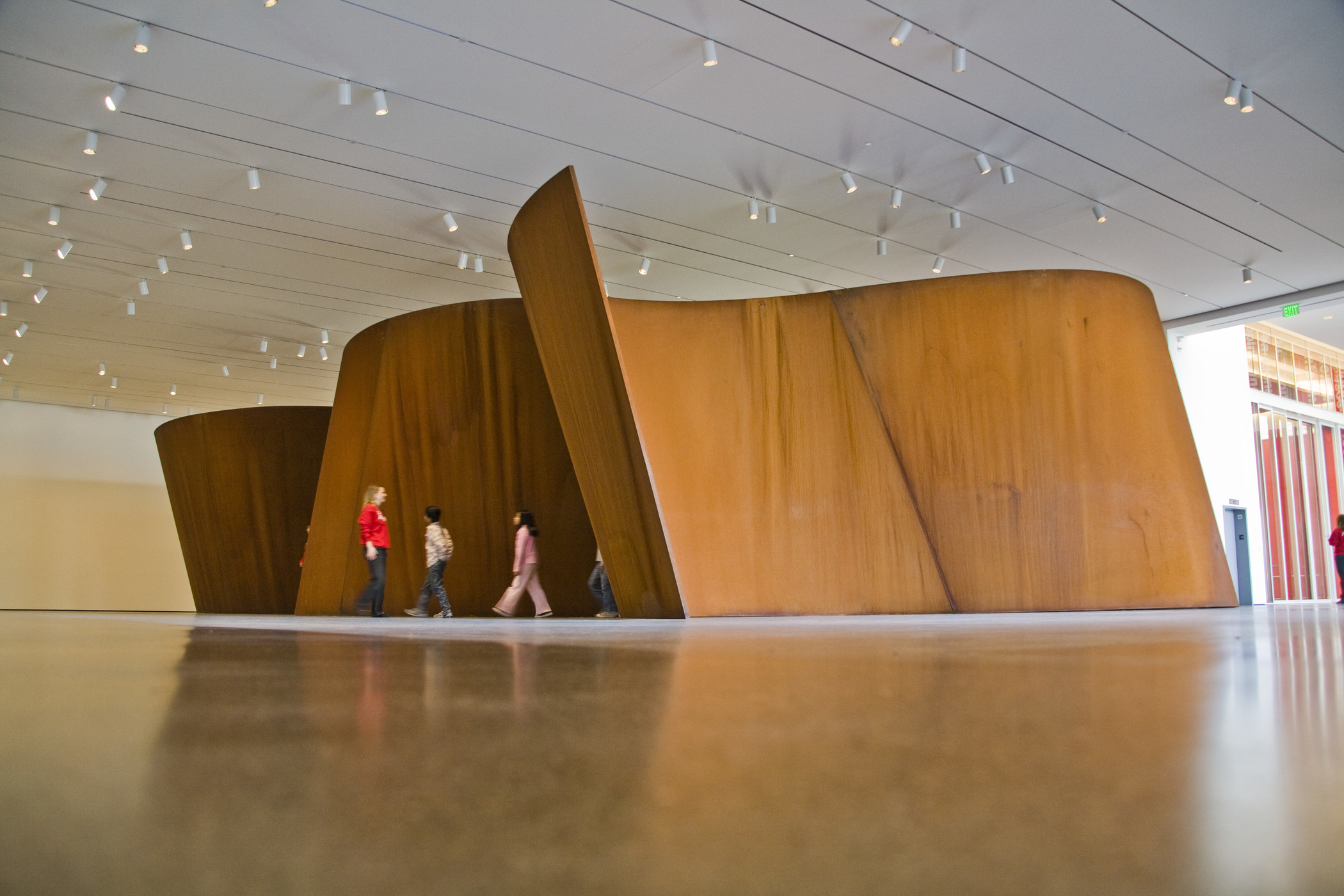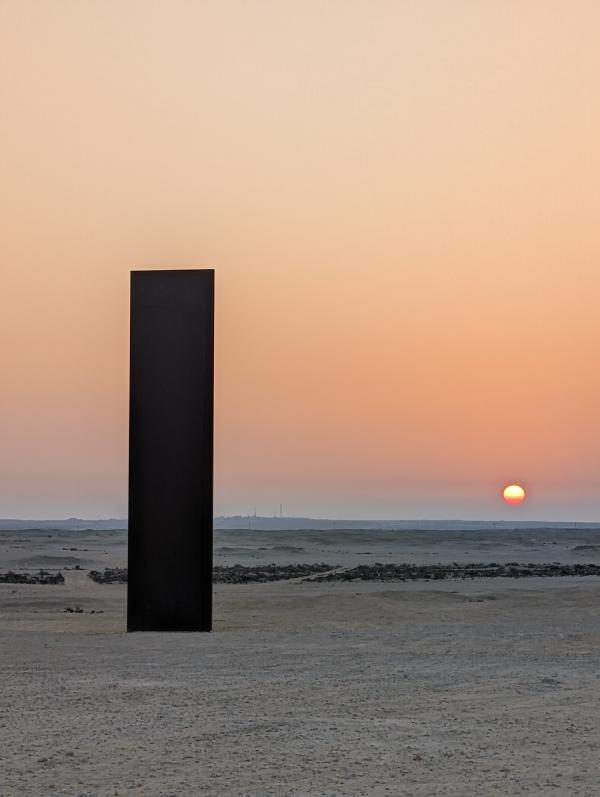Richard Serra, who died last week, relentlessly worked to push boundaries around the definition of sculpture. Deploying an extraordinary weight and measure of steel was one way he accomplished that. LACMA's enormous, weighty, long, and sinuous sculpture titled Band, generously donated by Edye and Eli Broad, is a perfect example. It is sculpture becoming an architecture of pure form. But unlike architecture it doesn't traditionally delineate an inside from an outside. It rhythmically holds and opens space. Walking alongside the winding path of the tall undulating band of velvety rust-brown steel, one feels that it’s the space of one’s experience that is undulating—those walls alternately leaning over and then away from your body as they draw you alternately inside and outside the sculpture.

Band is perhaps the most evolved expression of an innovative series of work Serra began in 1997 titled Torqued Ellipses. I was lucky enough to be working with Richard as he was struggling to birth his new forms. As director of Dia Art Foundation, working with curator Lynne Cooke (who authored LACMA's recent Woven Histories exhibition), we took a huge risk to empty out and prepare a building for Serra's new work, which he had envisioned and modeled, but not yet made.
There was no precedent for the geometry of form the artist had sketched. He planned a huge ellipsoid steel enclosure that was literally torqued. Imagine holding an ellipse-shaped can open on top and bottom and twisting it. Serra had already been working with large curved steel plates —most famously, Tilted Arc, a lengthy curve on the plaza in front of a government building that was controversially removed and caused years of stress and painful legal proceedings pitting artists' rights against popular public opinion. But there was no template or manufacturing precedent for the continuously complex curve he designed, nevermind a way to build it in two-inch thick Corten steel.
His architect friend, Frank Gehry, offered to lend his new high-tech CATIA computer-based design software, but in the end Serra's DIY design aid was decidedly low-tech. He cut two identical ellipses out of plywood turned at a slight angle from each other with a dowel between them, like a wobbly wheel which rolled over and wrapped up a soft sheet of lead. After slicing the excess lead away from the plywood and laying out the resulting lead sheet, what resulted was a measurable curvy plane that could be wrapped back around and stood up. Not quite closed, a space was left in between for a person to enter in the full-size sculpture. The artist was able to use this scale model to devise a more precise measurement system to bend steel through giant rollers designed to shape steel for a large ship's hull (found at Bethlehem Steel factory in Baltimore).
It wasn't easy. Serra was distraught, but not defeated, when one of the first giant steel plates broke under the pressure of the unusual bending procedure. It was also not an easy moment for a museum director and curator who bet a large amount of Dia's resources on the unprecedented planned artwork. Finally four diversely shaped Torqued Ellipses were born, three of which we exhibited to huge public success at 545 West 22nd Street in the Chelsea district of Manhattan. With the artist's collaboration, and the generous support of art patrons Louise and Len Riggio, those three sculptures were joined by a "torqued spiral" in the former train shed of the Dia:Beacon museum we were building along the Hudson River. They remain there today as a monumentally serene experience of ever shifting space and light defined by continuously curving walls of steel, like LACMA’s own Band. If you look closely at those first Ellipses you can see the scars of heat and the struggle to forcibly bend recalcitrant steel plates into an elegant almost mystical geometry. The bottoms of those first sculptures don't always align with the ground. LACMA's sculpture, by contrast, was made several years later after Serra had constructed his own space and equipment to realize his dream of even larger torqued steel works. On the ground floor of BCAM you can marvel at the powerful and subtle precision of Band's almost effortlessly curving walls defining the space and time of our experience. Each of the 10 roughly 17-ton and almost 13-foot tall curved plates of Band can stand on its own, and are placed together with perfect seams to compress its more than 200 linear feet into a form approximately 72 feet high and 37 feet wide.
When he first introduced his new idea to us at Dia, Serra explained that the form was inspired by his experience in Rome of one of Baroque architect Francesco Borromini's fancifully curved church interiors. Serra recalled that it felt like the church was spinning around him, and he wondered what it would be like to experience a space that literally twisted around you. He also wanted to create sculpture that wasn't so much to look at as an object but rather to be experienced in time and space—like a complex architectural interior, or walking through a garden. Serra was as enamored of Japanese gardens as Baroque churches. It's especially relevant that Serra, early in his artistic career, collaborated with dancers and made some of his own often rhythmic gestural performances. Perhaps the most iconic photograph of Serra in action pictures him in a protective mask throwing molten lead against the corner of a wall and its floor. Recalling Jackson Pollock, a generation before, dripping paint on a canvas, Serra's gesture was also immortalized in one of artist Matthew Barney's films where Serra plays himself. Barney seized on the complexity and contradiction of the artist's masculine athletic gesture that contained the elegance of a dance.
Richard Serra embodied complexity and contradiction held in tension. He created sculptures of heavy steel plates floating on a seeming knife edge of collapse. He played with the limits of massive weight, measure, and geometry embodied in blocks of forged steel as well as working with torn up old strips of carpet dipped in rubber and scattered across the floor in a loose and random impermanent anti-form. He used industrial non-art materials, but he was ever having a dialogue with traditional sculpture, architecture, and painting. To prove that point, I was once able to install, at the Peggy Guggenheim Collection in Venice, Peggy's delicate Jackson Pollock drip painting next to Serra's 1966–67 Belts, a series of tangled loops of industrial vulcanized rubber belts hung in a series on the wall, the first bunch punctuated by a scribble of neon. It was the similarity of the gestures that mattered.
On two recent trips to Doha, working with our partners at Qatar Museums, I went to the 2014 work they, and our board member Sheikha al-Mayassa al-Thani, had commissioned from Serra in a nearby desert. It turned out to be his last large commission. Titled EAST-WEST / WEST-EAST, the work spans more than a kilometer in length, four huge standing rectangular steel plates spaced apart from each other in precise alignment, following the course of the sun. Each plate is over 14 meters high, but perfectly sized to their environment. As you get close, they're massive and tall. Being near one, facing its plane obliterates your sight of the others behind in the row. Yet each of these large slabs of steel, from the side, in the scale of the landscape, appear as a slight thin line connecting ground to sky. As you walk from plate to plate you measure your own time and space. Once you step back from the whole composition you see that the tops of the planes of steel are aligned with each other and with the tips of the surrounding desert plateaus. They connect the experience of these two chalky gypsum mesas on either side, as they march down the long desert floor trough between them toward the nearby ocean and the horizon, beyond which, during my last visit, a huge surreally orange sun was setting. As I felt Serra's mystical monoliths measuring space and time on my walk from the empty desert toward the low sun and sea horizon, I imagined the artist surely counted on this spectacularly romantic backdrop as a foil for his sober order of dark monochrome standing planes.
With Richard I experienced many long conversations balancing playful curiosity and serious opinions. Working with him on big projects was extremely serious, as serious as his inexhaustible commitment to interrogate the limits of sculpture, and the often life or death seriousness of moving and installing dangerously heavy materials.
I like to walk continuously along the edges of our sculpture Band, just inches from its surface, feeling the weight of its walls and their constantly changing curvature leaning over me and away from me as I move to interior and exterior space like I'm traversing a Möbius strip. Pausing in one of its darker, heavier, but fleeting interiors I can see the ellipsoid space twisting around me. As I step out and back from the architectonic whole, I perceive the exterior curved walls as separate forms, like the series of individual enclosures of the line of sculptures I know so well at Dia:Beacon. But I know that this thing is actually one continuous band of steel. I can feel multiplicity and unity at once. Intense materiality can also be mysterious. Over many visits to this LACMA artwork, and working with Richard himself, I have learned that in feeling gravity deeply there is an immense lightness of affect rising in its many-layered meanings that I can carry with me.



